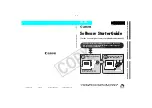
7 Cross Domain Configuration
This document describes how to configure the Acrobat family of products to allow cross domain access for
PDFs in one domain that attempt to access data from another domain. By default, when requested
content is not from the same origin as the requesting document, Acrobat and Adobe Reader automatically
attempt to load a server-based policy file from that domain to get permission for such access. Default
behavior is subject to customization by administrators, IT, workflow stakeholders, and others who need to
enable or disable cross domain access.
Changes across releases: Cross domain support
Version
Change
9.0
Support for controlling cross domain access via policy files is introduced. The implementation leverages the Flash model.
9.1
Support for allowing cross domain access on a per document basis by identifying certified documents by the SHA-1 hash of
the signing certificate's public key. The hash is added to the cross-domain policy file.
8.1.7 & 9.2
Enhanced security added for 8.1.7.
8.2 & 9.3
• Enhanced security turned on by default. Enhanced security takes precedence of
Trust Manager internet access settings.
• On Windows, the ability to trust sites that the user already trusts via Internet
Explorer can be configured via the user interface or registry.
• A non-intrusive Yellow Message Bar (YMB) that doesn't block workflows replaces
many of the modal dialogs. Depending on how the client is configured, the YMB
appears at the top of the document and offers the user to trust the document
"once" or "always."
• Cross domain logging can be enabled and the log viewed via the user interface.
• cross-domain policy files support all the mime types specified in the
Cross
Domain Policy File Specification
.
7.1 Cross domain basics
7.1.1 Same-origin policies
As the Acrobat family of products became more powerful over the years (i.e. support for JavaScript and
web service interaction), the line between document and application gradually blurred. With the addition of
interactive form features, multimedia, and scripting, PDFs became more capable with each release. On
the one hand, support for JavaScript and dynamic content within a Web page allows developers to add
rich interactivity and behaviors to their content. Yet these features can be abused by attackers, and
default configurations for clients that support them make such attacks even more dangerous.
One of the earliest attempts to combat such attacks was Netscape's same-origin policy introduced with
Netscape Navigator 2.0. The policy prevented a document or script loaded from one origin from accessing
resources loaded from another origin. To counter the same-origin policy, a wide variety of attack patterns
evolved, including cross-site scripting (XSS) and cross-site request forgery (XSRF). These attack patterns
have one thing in common: they exploit the trust shared between a user and a website by circumventing
its primary protection mechanism (the same-origin policy).
Adobe began addressing this problem several releases ago by implementing a standardized
cross-domain security model that has evolved over the years into a robust, secure solution. By providing
controls for who may receive data from whom, Adobe clients such as Flash and rich PDF documents are
safe and extremely flexible.
Application Security Guide
Section 7 Cross Domain Configuration
Section 7 Cross Domain Configuration
Page 51
















































